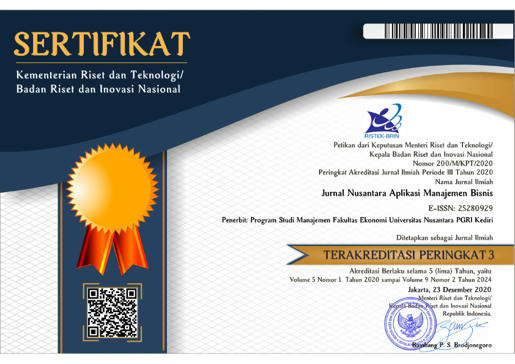Peran Entrepreneurial Marketing dalam Memediasi Kompetensi Sumber Daya Manusia dan Inovasi untuk mencapai Keunggulan Kompetitif
DOI:
https://doi.org/10.29407/nusamba.v6i2.16246Keywords:
Kompetensi SDM, Inovasi, Entrepreneurial Marketing, Keunggulan BersaingAbstract
This study aims to determine the effect of HR competence and innovation on competitive advantage with entrepreneurial marketing as an intervening variable in the Food and Beverage Industry in East Java. This research is a quantitative research. The sample was determined as many as 100 entrepreneurs by purposing sampling technique. The data obtained from the questionnaire was then analyzed using SEM with the Smart PLS application tool. The results showed that the competence of HR and entrepreneurial marketing partially had a significant positive effect on competitive advantage, while innovation had no significant effect on competitive advantage. HR competence and innovation significantly affect entrepreneurial marketing. Likewise, it is proven that entrepreneurial marketing is proven to be able to mediate HR competencies and innovation to competitive advantage.
Downloads
References
Eggers, F., O’Dwyer, M., Kraus, S., Vallaster, C., & Güldenberg, S. (2013). The impact of Brand Authenticity on Brand Trust and SME growth: A CEO perspective. Journal of World Business, 48(3). https://doi.org/10.1016/j.jwb.2012.07.018.
Muhammad, M. Z.-, Char, A. K., Yasoa’, M. R. bin, & Hassan, Z. (2009). Small and Medium Enterprises (SMEs) Competing in the Global Business Environment: A Case of Malaysia. International Business Research, 3(1). https://doi.org/10.5539/ibr.v3n1p66.
Naidoo, V. (2010). Firm survival through a crisis: The influence of market orientation, marketing innovation and business strategy. Industrial Marketing Management, 39(8). https://doi.org/10.1016/j.indmarman.2010.02.005.
Eniola, A., & Ektebang, H. (2014). SME firms Performance In Nigeria: Competitive Advantage and its Impact. International Journal of Research Studies in Management, 3(2). https://doi.org/10.5861/ijrsm.2014.854.
Wahyudin, N. (2015). Analisis Faktor-Faktor yang Mempengaruhi Keunggulan Bersaing untuk Meningkatkan Kinerja Perguruan Tinggi Swasta (PTS) pada Sekolah Tinggi dan Akademi di Semarang. Holistic Journall of Management Research.
Satria Widiarsa, I. B. I., & Sulistyawati, E. (2018). Peran Keunggulan Kompetitif Memediasi Pengaruh Green Marketing terhadap Keputusan Pembelian (Studi Pada Perusahaan Earth Café di Seminyak). E-Jurnal Manajemen Universitas Udayana, 7(7). https://doi.org/10.24843/ejmunud.2018.v07.i07.p01.
Hardum Suprianus Edi. (2021). Sektor Makanan Minuman Penyumbang PDB terbesar Non Migas. https://www.beritasatu.com/ekonomi/752649/sektor-makanan-dan-minuman-penyumbang-pdb-industri-nonmigas-terbesar, diakses tanggal 10 April 2021.
Becherer, R. C., Helms, M. M., & McDonald, J. P. (2012). The Effect of Entrepreneurial Marketing on Outcome Goals in SMEs. New England Journal of Entrepreneurship. https://doi.org/10.1108/neje-15-01-2012-b001.
Hidayatullah, S., Firdiansjah, A., Patalo, R. G., & Waris, A. (2019). The effect of Entrepreneurial Marketing and Competitive Advantage on Marketing Performance. International Journal of Scientific and Technology Research.
Mahrous, A., Genedy, M. A., & Kalliny, M. (2020). The Impact of Characteristics of Intra-Organizational Environment on Entrepreneurial Marketing Intensity and Performance in Egypt. Journal of Entrepreneurship in Emerging Economies. https://doi.org/10.1108/JEEE-08-2019-0115.
Morrish, S. C., Miles, M. P., & Deacon, J. H. (2010). Entrepreneurial Marketing: Acknowledging the Entrepreneur and Customer-Centric Interrelationship. Journal of Strategic Marketing, 18(4). https://doi.org/10.1080/09652541003768087.
Green, K. W., Zelbst, P. J., Meacham, J., & Bhadauria, V. S. (2012). Supply Chain Management: An International Journal Green Supply Chain Management Practices: impact on Performance. Supply Chain Management: An International Journal, 17.
Jones, C. (2010). Materializing piety: Gendered Anxieties About Faithful Consumption in Contemporary Urban Indonesia. American Ethnologist, 37(4). https://doi.org/10.1111/j.1548-1425.2010.01275.x.
Alajmi, S. A., & Alenezi, M. A. (2016). Human Resource Management Practices And Competitive Advantage: The Mediator Role Of Person-Organization Fit. Global Journal of Human Resource Management.
} Mitchelmore, S., & Rowley, J. (2010). Entrepreneurial Competencies: A Literature Review and Development Agenda. In International Journal of Entrepreneurial Behaviour & Research. https://doi.org/10.1108/13552551011026995.
Nemli Çalişkan, E. (2010). The Impact Of Strategic Human Resource Management On Organizational Performance Stratejik İnsan Kaynaklari Yönetiminin Firma Performansina Etkisi Özet. Journal of Naval Science and Engineering, 6(2).
Afriyie, S., Du, J., & Musah, A. A. I. (2019). Innovation and Marketing Performance of SME in an Emerging Economy: The Moderating Effect of Transformational Leadership. Journal of Global Entrepreneurship Research, 9(1), 1–25.
Miles, M. P., & Darroch, J. (2006). Large firms, Entrepreneurial Marketing Processes, and the Cycle of Competitive Advantage. European Journal of Marketing, 40(5–6). https://doi.org/10.1108/03090560610657804.
Chang, C. H. (2011). The Influence of Corporate Environmental Ethics on Competitive Advantage: The Mediation Role of Green Innovation. Journal of Business Ethics.
Dereli, D. D. (2015). Innovation Management in Global Competition and Competitive Advantage. Procedia - Social and Behavioral Sciences. https://doi.org/10.1016/j.sbspro.2015.06.323.
Le, P. B., & Lei, H. (2018). The Effects of Innovation Speed and Quality on Differentiation and Low-Cost Competitive Advantage: The Case of Chinese Firms. Chinese Management Studies. https://doi.org/10.1108/CMS-10-2016-0195.
Mathenge, J. (2013). The Effect of Innovation on Competitive Advantage of Telecommunication Companies in Kenya. In a Research Project Submitted in Partial Fulfillment of the Requirements for the Degree of Master of Business Administration of the University of Nairobi.
Varadarajan, R. (2011). Conjectures on Innovation Drivers in an Emerging Market: India. In Handbook of Research in International Marketing, Second Edition. https://doi.org/10.4337/9781849806121.00013.
Udriyah, Tham, J., & Ferdous Azam, S. M. (2019). The Effects of Market Orientation and Innovation on Competitive Advantage and Business Performance of Textile SMEs. Management Science Letters. https://doi.org/10.5267/j.msl.2019.5.009.
Sadiku-Dushi, N., Dana, L. P., & Ramadani, V. (2019). Entrepreneurial Marketing Dimensions and SMEs Performance. Journal of Business Research. https://doi.org/10.1016/j.jbusres.2019.03.025.
Kumar, V., & Pansari, A. (2016). Competitive Advantage through Engagement. In Journal of Marketing Research. https://doi.org/10.1509/jmr.15.0044.
Hinterhuber, A. (2013). Can Competitive Advantage be Predicted? Management Decision. https://doi.org/10.1108/00251741311326572.
Porter, Michael E. (1998). Competitive Advantage: Creating and Sustaining Superior Performance. In The Free. https://doi.org/10.1016/j.neubiorev.2009.11.015.
Zekiri, J., & Nedelea, A. (2012). Strategies for Achieving Competitive Advantage. The USV Annals of Economics and Public Administration, 11(2), 63–73.
Li, S., Ragu-Nathan, B., Ragu-Nathan, T. S., & Rao, S. S. (2006). The Impact of Supplychain Management Practices on Competitive Advantage and Organizational Performance. Omega:The International Journal of Management Science, 34, 107 – 124.
Morris, M. H., Schindehutte, M., & LaForge, R. W. (2002). Entrepreneurial Marketing: A Construct for Integrating Emerging Entrepreneurship and Marketing Perspectives. Journal of Marketing Theory and Practice, 10(4). https://doi.org/10.1080/10696679.2002.11501922.
Jones, R., & Rowley, J. (2011). Entrepreneurial Marketing in Small Businesses: A Conceptual Exploration. International Small Business Journal. https://doi.org/10.1177/0266242610369743.
Carson, D., Cromie, S., McGotwan, P., & Hill, J. (1995). Marketing and Entrepreneurship in SMEs : An Innovative Appro. European Journal of Marketing.
Moore, R. C. (2017). Childhood’s Domain: Play and Place in Child Development. In Childhood’s Domain: Play and Place in Child Development. https://doi.org/10.4324/9781315121895.
Morrish, S. C. (2011). Entrepreneurial Marketing: A Strategy for the Twenty-first Century? Journal of Research in Marketing and Entrepreneurship, 13(2). https://doi.org/10.1108/14715201111176390.
Autio, E., Kenney, M., Mustar, P., Siegel, D., & Wright, M. (2014). Entrepreneurial Innovation: The Importance of context. Research Policy, 43 (7). https://doi.org/10.1016/j.respol.2014.01.015.
Agyapong, F. O., Agyapong, A., & Poku, K. (2017). Nexus between Social Capital and Performance of Micro and Small Firms in an Emerging Economy: The Mediating Role of Innovation. Cogent Business and Management, 4(1). https://doi.org/10.1080/23311975.2017.1309784.
Shahhosseini, V., & Sebt, M. H. (2011). Competency-Based Selection and Assignment of Human Resources to Construction Projects. Scientia Iranica. https://doi.org/10.1016/j.scient.2011.03.026.
Franco, M., Santos, M. de F., Ramalho, I., & Nunes, C. (2014). An Exploratory Study of Entrepreneurial Marketing in SMEs: The Role Of The Founder-Entrepreneur. Journal of Small Business and Enterprise Development. https://doi.org/10.1108/JSBED-10-2012-0112.
Gordon. (1998). Pembelajaran Kompetensi. Jakarta. Rineka Cipta.
Ceylan, C. (2013). Commitment-based HR Practices, Different Types of Innovation Activities and Firm Innovation Performance. International Journal of Human Resource Management. https://doi.org/10.1080/09585192.2012.680601
Andries, P., & Czarnitzki, D. (2014). Small Firm Innovation Performance and Employee Involvement. Small Business Economics. https://doi.org/10.1007/s11187-014-9577-1.
Prajogo, D. I. (2016). The Strategic Fit between Innovation Strategies and Business Environment in Delivering Business Performance. International Journal of Production Economics. https://doi.org/10.1016/j.ijpe.2015.07.037.
Atalay, M., Anafarta, N., & Sarvan, F. (2013). The Relationship Between Innovation and Firm Performance: An Empirical Evidence from Turkish Automotive Supplier Industry. Procedia - Social and Behavioral Sciences. https://doi.org/10.1016/j.sbspro.2013.04.026 https://doi.org/10.1007/s10551-011-0914-x.
Vaccaro, I. G., Jansen, J. J. P., van den Bosch, F. A. J., & Volberda, H. W. (2012). Management Innovation And Leadership: The Moderating Role of Organizational Size. Journal of Management Studies. https://doi.org/10.1111/j.1467-6486.2010.00976.x
Collinson, E., & Shaw, E. (2001). Entrepreneurial Marketing – a Historical Perspective on Development and Practice. Management Decision, 39(9). https://doi.org/10.1108/EUM0000000006221.
OECD/Eurostat. (2005). Oslo Manual: Guidelines for Collecting and Interpreting Innovation Data, 3rd Edition, The Measurement of Scientific and Technological Activities. In Communities: Vol. Third edit.
Cooper, D. R., & Schindler, P. S. (2003). Business Research Methods. In Business.
Ghozali & Latan. (2015). Partial Least Square SEM (PLS - SEM). Partial Least Square.
Ahmad, N. H., Halim, H. A., & Zainal, S. R. M. (2010). Is Entrepreneurial Competency the Silver Bullet For SME Success in a Developing Nation? International Business Management. https://doi.org/10.3923/ibm.2010.67.75
Gerardo Barroso Tanoira, F., & Alberto Santos Valencia, R. (2014). Knowledge Management, Entrepreneurial Competencies and Organizational Development in Micro and Small Enterprises in Rural Regions in the State of Yucatan, Mexico. European Scientific Journal, 10(1).
Downloads
Published
Issue
Section
License
Authors who publish with this journal agree to the following terms:
- Copyright on any article is retained by the author(s).
- The author grants the journal, the right of first publication with the work simultaneously licensed under a Creative Commons Attribution License that allows others to share the work with an acknowledgment of the work’s authorship and initial publication in this journal.
- Authors are able to enter into separate, additional contractual arrangements for the non-exclusive distribution of the journal’s published version of the work (e.g., post it to an institutional repository or publish it in a book), with an acknowledgment of its initial publication in this journal.
- Authors are permitted and encouraged to post their work online (e.g., in institutional repositories or on their website) prior to and during the submission process, as it can lead to productive exchanges, as well as earlier and greater citation of published work.
- The article and any associated published material is distributed under the Creative Commons Attribution-ShareAlike 4.0 International License












